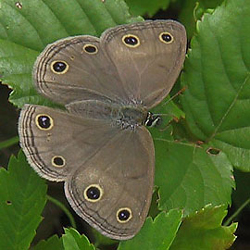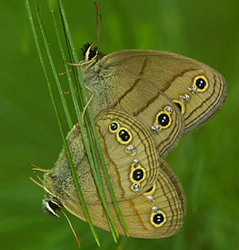Butterfly Atlas
Find a Butterfly
Little Wood Satyr
Megisto cymela
Named
Cramer, 1777

Identification
Wingspan: 1 3/4 1 7/8". Of the six superficially similar satyrs occurring in the East, this is the only one ranging north of New Jersey, thus making identification in Massachusetts fairly straightforward. The Little Wood Satyr is dusky brown above and light brown beneath, with two prominent eyespots on each wing, above and below. A pair of dark brown bands span the underside of both wings.
Distribution
Southeastern Saskatchewan east to Nova Scotia and south through the United States, east of the Rocky Mountains. In New England, the species ranges north to northern Vermont and New Hampshire and central Maine.
Status in Massachusetts
Although rare or absent from northernmost New England, the Little Wood Satyr is widespread and common throughout most of the East, including Massachusetts. Scudder referred to it here as "excessively abundant", while Farquhar called it general and common in southern New England. The species is apparently absent, or virtually so, on Nantucket, which has but one historical record. Maximum: 302, Foxboro (Norfolk Co.), 7 June 1992.

Flight Period in Massachusetts
Late May to early August. Extreme dates: 24 May 1993, Sudbury (Middlesex Co.), T. Dodd, and 7 August 1987, S. Wellfleet (Barnstable Co.), S. Mansur. Opler and Krizek suggest that, based on flight dates of populations studied in Pennsylvania and Virginia, "two cryptic sibling species must be involved" in various parts of the Little Wood Satyr‘s range. Perhaps this is the case in Massachusetts, where dates of Atlas specimens show two peaks of occurrence, one in early June and the other, significantly smaller, in mid July. Scudder was puzzled by the appearance of fresh butterflies in mid summer and thought these might be slowly developing individuals of the main flight, or "an accidental offshoot trying to perpetuate itself...and taking like the alternate brood an entire year for the completion of its cycle."
Larval Food Plants
Larvae feed on a variety of grasses, including Orchard Grass, (Dactylis glomerata), and perhaps various sedges.
Adult Food sources
Flower nectar is rarely utilized, although the species is known to visit pale flowers occasionally. During the Atlas, it was seen nectaring at dogbane, Sweet Pepperbush, Gray-stemmed Dogwood, and New Jersey Tea. Tree sap and aphid honeydew are also documented dietary items (Opler and Krizek, 1984).

Habitat
The Little Wood Satyr is essentially a species of deciduous woodland edges and is most often encountered where meadows or woodlands meet, flying within the shade of bordering shrubs and trees.
Life Cycle
EGG: Very pale green; globular, with fine reticulations. OVIPOSITION: Eggs laid singly on blades of grass, living or dead, or on the ground. LARVA: Greenish brown, with lighter lengthwise stripes and numerous tubercles. CHRYSALIS: Yellow brown and unadorned. OVERWINTERING STAGE: Late instar larva.
Hibernating caterpillars, nearly fully grown, emerge from the leaf litter in May and continue their feeding through the final instar. Pupation lasts about 8 days, and by late May numbers of adults are patrolling field edges with a characteristic skipping, bobbing flight. Males spend a good deal of their adult lives cruising their favored haunts in search of receptive females. Adults are active insects, and are said to fly frequently among the treetops (Opler and Krizek, 1984), although far greater numbers patrol within three or four feet of the ground. Sunning with outstretched wings occurs during the early morning and late afternoon.
Account Author
Brian Cassie



